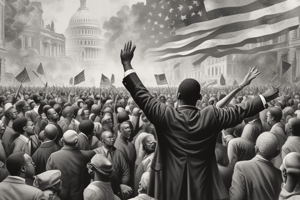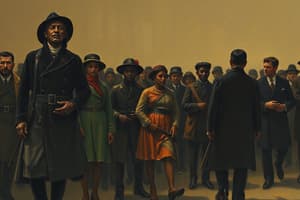Podcast
Questions and Answers
What was one significant outcome of the Brown v. Board of Education case?
What was one significant outcome of the Brown v. Board of Education case?
What factor contributed to the slow implementation of desegregation after the Brown ruling?
What factor contributed to the slow implementation of desegregation after the Brown ruling?
How did the murder of Emmett Till influence public awareness of racial injustice?
How did the murder of Emmett Till influence public awareness of racial injustice?
Who was a key figure in the Montgomery Bus Boycott?
Who was a key figure in the Montgomery Bus Boycott?
Signup and view all the answers
What was a direct outcome of the Montgomery Bus Boycott?
What was a direct outcome of the Montgomery Bus Boycott?
Signup and view all the answers
What was a notable failure faced by civil rights activists during the Eisenhower era?
What was a notable failure faced by civil rights activists during the Eisenhower era?
Signup and view all the answers
What role did the NAACP play in the Brown v. Board of Education case?
What role did the NAACP play in the Brown v. Board of Education case?
Signup and view all the answers
Which of the following was a factor that contributed to the backlash against civil rights advancements in the South?
Which of the following was a factor that contributed to the backlash against civil rights advancements in the South?
Signup and view all the answers
What was a common strategy employed during the Montgomery Bus Boycott?
What was a common strategy employed during the Montgomery Bus Boycott?
Signup and view all the answers
What was a key decision made by Chief Justice Earl Warren in the Brown case?
What was a key decision made by Chief Justice Earl Warren in the Brown case?
Signup and view all the answers
Which statement best describes the public reaction to the ruling in Brown v. Board of Education?
Which statement best describes the public reaction to the ruling in Brown v. Board of Education?
Signup and view all the answers
What was a significant barrier to justice for Emmett Till?
What was a significant barrier to justice for Emmett Till?
Signup and view all the answers
In what way did the Brown v. Board of Education ruling impact civil rights movements?
In what way did the Brown v. Board of Education ruling impact civil rights movements?
Signup and view all the answers
What was one of the outcomes of the media coverage of Emmett Till's funeral?
What was one of the outcomes of the media coverage of Emmett Till's funeral?
Signup and view all the answers
What action did Rosa Parks' arrest lead to?
What action did Rosa Parks' arrest lead to?
Signup and view all the answers
What was the duration of the bus boycott in Montgomery?
What was the duration of the bus boycott in Montgomery?
Signup and view all the answers
What did President Eisenhower do in response to the situation at Little Rock Central High School?
What did President Eisenhower do in response to the situation at Little Rock Central High School?
Signup and view all the answers
What was the outcome of the attempts to integrate schools in Little Rock, Arkansas?
What was the outcome of the attempts to integrate schools in Little Rock, Arkansas?
Signup and view all the answers
What significant event occurred involving the Woolworth's lunch counter in Greensboro?
What significant event occurred involving the Woolworth's lunch counter in Greensboro?
Signup and view all the answers
What hypocrisy was highlighted by the Woolworth's protests?
What hypocrisy was highlighted by the Woolworth's protests?
Signup and view all the answers
Which governor of Arkansas actively opposed the integration of schools?
Which governor of Arkansas actively opposed the integration of schools?
Signup and view all the answers
How did the black students in Little Rock face challenges when trying to enter the school?
How did the black students in Little Rock face challenges when trying to enter the school?
Signup and view all the answers
What did the term 'Lost Year' refer to in the context of Little Rock schools?
What did the term 'Lost Year' refer to in the context of Little Rock schools?
Signup and view all the answers
Which method did the Montgomery Improvement Association promote?
Which method did the Montgomery Improvement Association promote?
Signup and view all the answers
What was the role of the National Guard during the integration crisis in Little Rock?
What was the role of the National Guard during the integration crisis in Little Rock?
Signup and view all the answers
What was the overall goal of the Montgomery bus boycott?
What was the overall goal of the Montgomery bus boycott?
Signup and view all the answers
Why did Faubus close schools rather than allow desegregation?
Why did Faubus close schools rather than allow desegregation?
Signup and view all the answers
What did the student protests in Greensboro signify in the context of the civil rights movement?
What did the student protests in Greensboro signify in the context of the civil rights movement?
Signup and view all the answers
Study Notes
Civil Rights Incidents and Cases in the Eisenhower Era (1953-1960)
-
Brown v. Topeka Board of Education (1954): Linda Brown was forced to attend a school 20 blocks away due to a white-only school closer to home. The NAACP took this to the Supreme Court, arguing against the 14th Amendment, which protects equality. The Supreme Court unanimously ruled that segregation in schools based on race was unconstitutional. This overturned the Plessy v. Ferguson ruling.
-
Key Civil Rights Organizations: Several organizations played important roles in the movement. The NAACP (National Association for the Advancement of Colored People) supported the legal challenge in the Brown case and also coordinated many of the initiatives. The SNCC (Student Nonviolent Coordinating Committee) co-ordinated some initiatives. The SCLC (Southern Christian Leadership Conference) played a significant role in organising and focusing efforts in the deep South.
-
Key People: Thurgood Marshall, Linda Brown, and Oliver Brown, and Earl Warren had prominent roles in the Brown case. The Bryants, shop keepers, were involved incidents in relation to Emmett Till's murder. Mamie Till was a key figure in the Emmett Till case. Rosa Parks, Martin Luther King, Jr. were involved in the Montgomery incident. Ernest Greene, Elizabeth Eckford, and Orval Faubus were involved in the Little Rock incident. The Greensboro Four were involved in the Woolworth Sit-ins
-
Emmett Till Murder (1955): Emmett Till's murder was a significant event that brought attention to racial violence and injustice in the South. The trial and lack of justice highlighted the widespread violence against African Americans
-
Montgomery Bus Boycott (1955-1956): A series of incidents involving AAs being asked to move to the back of buses unnecessarily led to a boycott. Rosa Parks was selected to highlight the issue. This sparked a widespread boycott of Montgomery's buses by the AA community for 382 days. This led to the creation of the Montgomery Improvement Association (MIA)
-
Little Rock School Desegregation (1957): Nine Black students attempted to integrate Little Rock Central High School. The Governor of Arkansas, Orval Faubus, sent in the National Guard to prevent them from entering. President Eisenhower sent federal troops to escort the students into school.
-
Woolworth Sit-ins (1960): Four students refused to move from a "whites only" lunch counter in Greensboro, North Carolina. This protest started a series of sit-ins across the country that brought pressure on businesses to desegregate.
-
Progress: While some progress occurred regarding the desegregation of schools and businesses, violence and resistance persisted. In some contexts, de-segregation progressed slowly in some areas and resistance remained throughout this period. Presidential (Eisenhower's) comments and actions varied on the level of involvement in these cases. There were both successes and failures at achieving progress in certain sectors.
Studying That Suits You
Use AI to generate personalized quizzes and flashcards to suit your learning preferences.
Related Documents
Description
Test your knowledge on key civil rights incidents and cases that defined the Eisenhower era from 1953 to 1960. Explore pivotal events like Brown v. Topeka Board of Education and the roles of major civil rights organizations and figures. Understand how these developments shaped the fight for equality in the United States.




